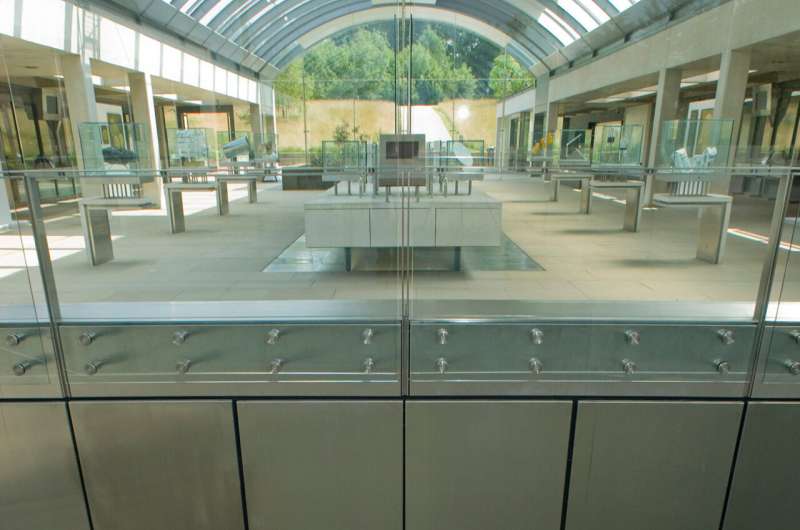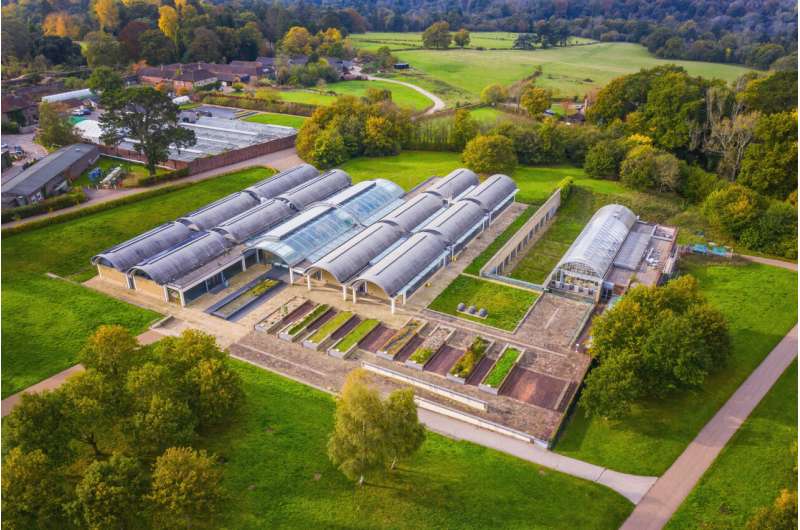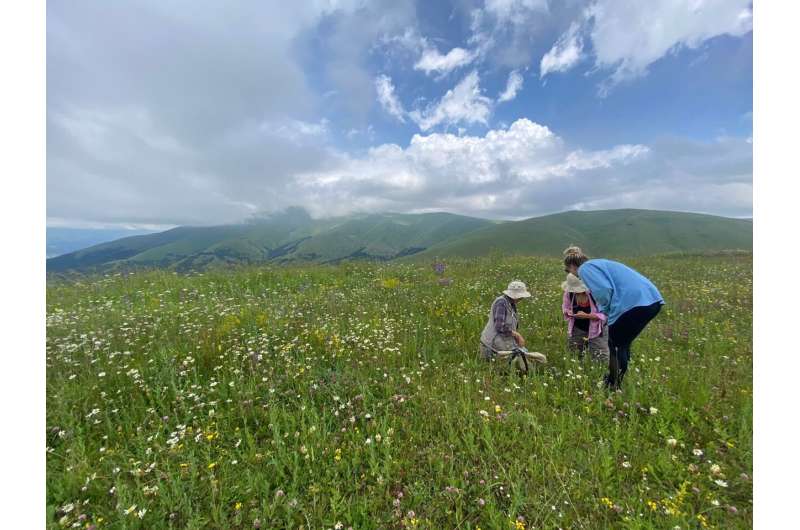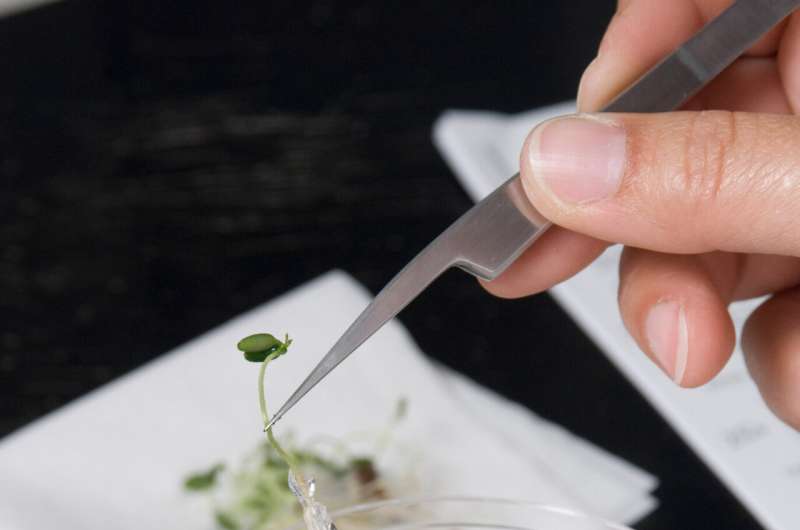This article has been reviewed according to Science X's editorial process and policies. Editors have highlighted the following attributes while ensuring the content's credibility:
fact-checked
trusted source
proofread
'Noah's Ark for plants' hits major milestone: 40,000 plant species now banked at Kew's Millennium Seed Bank

A world-leading seed conservation program led by the Royal Botanic Gardens, Kew is celebrating a major milestone today in its efforts to preserve rare, threatened, and important wild plants. As of March 1, the Millennium Seed Bank (MSB) has banked more than 2.4 billion individual seeds representing a total of 40,020 different species of wild plants.
Described by scientists as "Noah's Ark for plants," the MSB is the world's biggest wild seed storage facility, situated at the heart of Kew's 'living laboratory' and wild botanic gardens, Wakehurst, in rural Sussex. Within the bomb- and flood-proof building are 98,567 seed collections sourced from 190 countries and territories, across all seven continents, nine biogeographic regions, and 36 biodiversity hotspots. In fact, the MSB holds the Guinness World Records title for world's "largest seed bank."
Dr. Elinor Breman, Senior Research Leader at the Millennium Seed Bank, says, "Housed within the vaults of the Millennium Seed Bank is the world's largest and most diverse collection of plants anywhere on the planet and that makes it an invaluable tool for scientists tackling the global biodiversity crisis. The path towards banking 40,000 individual species has been both challenging and rewarding and we are confident the coming years will prove just as fruitful. Conserving seeds at the MSB is not just about chasing numbers, it's about increasing the genetic diversity of the collections and unlocking their potential to solve some of the biggest challenges we face today, from biodiversity loss to food security to climate change."
Lord Benyon, the UK Government's Minister for Biosecurity, says, "Kew's world leading collection of diverse plants will be an important tool in tackling the challenges facing our nation today, including maintaining our food security, biosecurity loss and climate change. This landmark collection acts as a further example of Great Britain's position as a global leader in plant biosecurity and sets an example for the world to follow."
What species were added?
Among the most recent additions to the seed bank, pushing the number of collected species over 40,000, are wild plants from Madagascar, Pakistan, and the Caucasus. These include the critically endangered baobab Adansonia perrieri, or Perrier's baobab, and the endangered Erythrophleum couminga, a leguminous tree endemic to the Bare de Ball National Park on the west coast of Madagascar. Although the stems and leaves of the latter are known to be used as a cardiac tonic, the plant is highly poisonous in high doses and its bark extract can cause shortness of breath, seizures, and even cardiac arrest.
Other recent highlights include a number of orchid species collected throughout the Caucasus region, such as Orchis coriophora, where the MSB is coordinating a dedicated seed conservation program in Armenia. Orchid seeds are particularly tricky to collect and conserve as they are the smallest in the world, a single plant producing millions of dust-like seeds. Because of their minuscule size, they lack a food reserve and are generally unable to germinate on their own. Instead, many species rely on fungal partners—so-called mycorrhizal relationships—to germinate. Orchid seeds are also difficult to store but researchers at the MSB and in partner countries are developing new methods to maximize their longevity.

Why it matters
According to Kew's State of the World's Plants and Fungi report in 2020, two in five plants globally are threatened with extinction due to the degradation of natural ecosystems, land use change, and increasingly the uncertainties caused by climate change. Now, more than ever, scientists believe steps need to be taken to enact nature-positive change for the future. Ex-situ conservation, such as seed banking, has been identified as one way of protecting biodiversity and the genetic variety contained within.
Unlike partner gene banks focused on backing up the diversity of both domesticated and wild plants, such as the Svalbard Global Seed Vault for food crops, the MSB's collections only represent threatened and wild useful plants. Wild plants, such as the crop wild relatives of the popular crops we consume, hold a much wider diversity of genes and traits that researchers are hoping can unlock the potential to target challenges including climate change, drought, disease, and pests.
In 2010, naturalist Sir David Attenborough dubbed the MSB "perhaps the most significant conservation initiative ever," highlighting the importance of ex-situ conservation. He then reiterated this message in the Sky Atlantic documentary series Kingdom of Plants, when he said the MSB is not only "an insurance policy against the ultimate apocalypse" but a resource for saving plants "teetering on the edge of extinction."
Dr. Kate Hardwick, Conservation Partnership Coordinator at the MSB, says, "Scientists at Kew estimate that two-fifths of all plants are threatened with extinction in the wild and that shows us just how big of a crisis we are facing in terms of biodiversity loss, driven very much by habitat loss and climate change. In a bid to tackle these issues, Kew established the Millennium Seed Bank more than 20 years ago to provide a safety net that would safely store the seeds of wild plants from all over the globe. Working with over 260 partners in at least 97 different countries, Kew has effectively created a Noah's Ark for plants, ensuring their survival in the race against extinction."
Protecting biodiversity goes beyond simply earmarking the most threatened and useful plants for conservation, it involves protecting the incredible genetic diversity contained within. This includes, for example, conserving the crop wild relatives of the foods we consume today by preserving their natural ecosystems (in-situ conservation) and storing their genetic material in seed banks (ex-situ conservation).
By 2020, the MSB Partnership's global seed banking efforts saw at least 350 partners in 74 countries store the seeds of more than 57,000 species in seed banks around the world. Target 8 of the Global Strategy for Plant Conservation 2011-2020, published by the United Nations Convention on Biological Diversity (CBD), called for at least 75% of threatened plant species to be held in ex-situ collections, including living plants in botanic gardens, as well as at least 75% of known threatened plants to be conserved in-situ.

Journey of a seed
Seeds arrive at the MSB in various forms and states, sometimes still attached to plants and fruit. Before they can be stored in the facility's underground vaults, they are dried in a dry room at 15% relative humidity and 15˚C, prior to processing, when they are cleaned and x-rayed for signs of pests and poorly formed embryos. They are then re-dried to extend their storage life, with a seed's lifespan doubled for every 1% reduction in its moisture content.
After drying, the seeds are typically at 3-6% moisture content—extracting all the water from the seeds can be damaging. Once ready, the seeds are placed in sealed glass containers and stored in a cold room at -20˚C to ensure their survival for up to hundreds of years. Every 10 years, seeds are withdrawn to test their germination viability.
In addition to being stored in the MSB's vaults, at least half of the seeds collected abroad are stored in the country of origin. Doing so adds an additional level of security, makes seed collections more accessible to scientists and governments internationally, and helps foster relationships between Kew and its partners.
Interesting species include
Among the most interesting specimens within the MSB's collections are the seeds of plants deemed threatened or already extinct in the wild. These include the yellow fatu flower (Abutilon pitcairnense), the world's smallest waterlily (Nymphaea thermarum), and a rare and threatened pea unique to eastern Australia that is known as clover glycine (Glycine latrobeana). In 2020, 250 seeds of clover glycine were withdrawn from the MSB and sent to the South Australian Seed Conservation Centre for propagation, to help the restoration of the Cudlee Creek fire scar.
Some of the latest accessions include seeds of Antarctic hair grass (Deschampsia antarctica)—one of the only two flowering plants native to Antarctica—collected during a field trip earlier in 2022. The seeds of this remarkable plant have been recently requested by a Ukrainian researcher exiled to Germany, who has been unable to carry out his research in Kyiv due to the ongoing war.
However, 8-20% of flowering plants are so-called recalcitrant species—they cannot be conventionally stored in the MSB as their seeds do not tolerate drying. Scientists are, consequently, investigating technologies such as cryo-preservation (rapidly freezing and storing seeds at low temperatures) to increase their preservation viability.

Using the seeds—from seed to seedling to plant
Germination specialists at the MSB test seeds every ten years for two reasons: to monitor the viability of individual collections, and to develop protocols for turning the seeds into full-grown plants. The seeds are germinated in petri dishes with agar—a jelly-like substance made from algae, which is a very convenient water supplying substrate—and in some cases are gently cut open or 'chipped' to allow water inside and overcome dormancy.
Rachael Davies, Germination Specialist, says, "Research into seed dormancy, germination, viability, and longevity is a valuable tool that helps us solve many collection-related problems. Developing germination protocols and overcoming these issues also enables both seeds and plants to be available for research and conservation, maximizing their potential use for habitat repair or sustainable use projects."
Some of the seeds that start to produce shoots are transferred to the MSB Nursery, where they are planted in a compost mix by horticulturists in Wakehurst's Plant Propagation and Conservation Unit. If successful, the seedlings will take root in the compost and continue to grow under a horticulturist's watchful eye.
A globally connected partnership
The MSB's collections are in a state of constant flux as seeds move in and out of its vaults, taxonomists revise species, or seeds are withdrawn for research purposes. Globally, the number of species conserved by the MSB Partnership (MSBP) is also higher than the individual collections stored at Wakehurst and represents nearly 57,500 species of wild plants. Seeds collected through the MSBP are duplicated to the seed bank under the Convention for Biological Diversity and Nagoya Protocol.
The MSBP is, consequently, as much an insurance policy for the future of global biodiversity, as it is a tool for fostering new relationships and seed storage capacity within partnered countries. Towards this goal, the MBSP Seed Conservation Standards provide a useful toolkit for countries and institutions to increase the quality and diversity of their seed collections under a common, internationally recognized conservation standard.
Successful partnerships include a long-standing collaboration with the South Africa National Biodiversity Institute (SANBI) to help develop and fund a national seed collection for South Africa—home to more than 21,000 species of plants. Working with partners across more than 100 countries since the year 2000, has allowed the MSB to become the largest and most genetically diverse resource of plant knowledge on the planet.
Provided by Royal Botanic Gardens, Kew





















